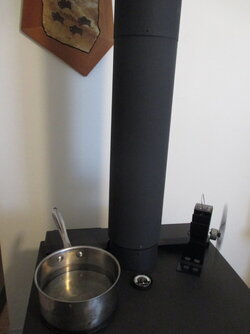So, I took a hand-held bathroom mirror and a strong headlamp, opened the bypass door, then shone the light up the chimney and used the mirror to see how I've been doing. I've been burning for two and a half months and wanted to see about creosote buildup. It kind of looks a little like those old "popcorn stucco" ceilings we used to see in old motel ceilings, but not as bumpy. And, of course, a kind of dull grey colour. Inside the fire box, I've got more buildup, looking a little tarry in the corners and chunks are peeling off.
Anyway, I'm looking for some tips to clean with a Sooteater or similar tool. I still have to buy one and I want to clean out the chimney. It's been a very mild winter here so far (was 7° C/45° F) for the last two days. Anyway, I have a stainless steel double walled chimney which is good, hard to damage them, I've been told. But, best to avoid chimney fires anyway, of course. Anyway... please let me know if you've cleaned out a chimney through the firebox in a BK and what to avoid, what to expect, etc. Any tips gratefully accepted!
Anyway, I'm looking for some tips to clean with a Sooteater or similar tool. I still have to buy one and I want to clean out the chimney. It's been a very mild winter here so far (was 7° C/45° F) for the last two days. Anyway, I have a stainless steel double walled chimney which is good, hard to damage them, I've been told. But, best to avoid chimney fires anyway, of course. Anyway... please let me know if you've cleaned out a chimney through the firebox in a BK and what to avoid, what to expect, etc. Any tips gratefully accepted!


